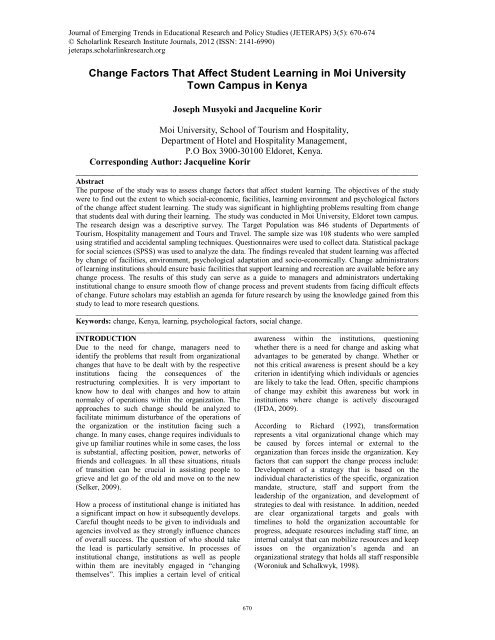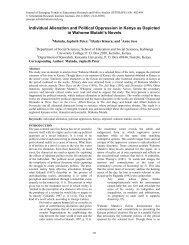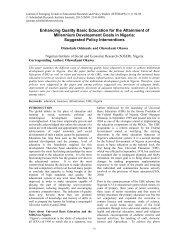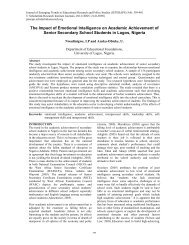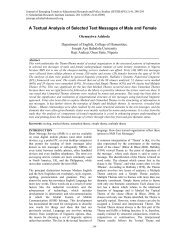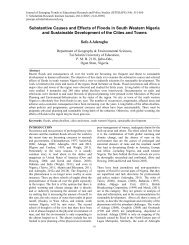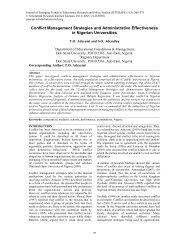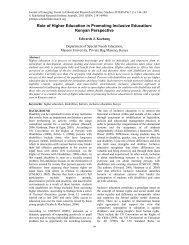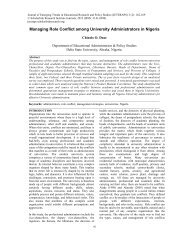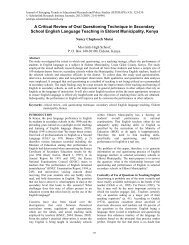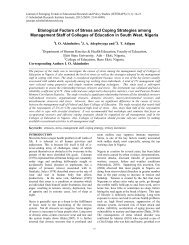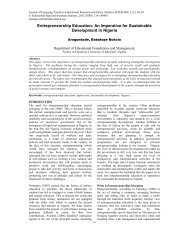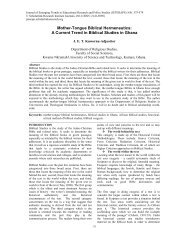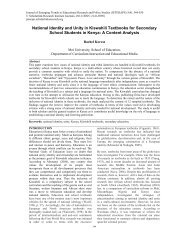Change Factors That Affect Student Learning in Moi University Town ...
Change Factors That Affect Student Learning in Moi University Town ...
Change Factors That Affect Student Learning in Moi University Town ...
Create successful ePaper yourself
Turn your PDF publications into a flip-book with our unique Google optimized e-Paper software.
Journal 5 of Emerg<strong>in</strong>g Trends <strong>in</strong> Educational Research and Policy Studies (JETERAPS) 3(5): 670-674<br />
Journal © Scholarl<strong>in</strong>k of Emerg<strong>in</strong>g Research Trends Institute <strong>in</strong> Educational Journals, 2012 Research (ISSN: and 2141-6990) Policy Studies (JETERAPS) 3(5):670-674 (ISSN:2141-6990)<br />
jeteraps.scholarl<strong>in</strong>kresearch.org<br />
<strong>Change</strong> <strong>Factors</strong> <strong>That</strong> <strong>Affect</strong> <strong>Student</strong> <strong>Learn<strong>in</strong>g</strong> <strong>in</strong> <strong>Moi</strong> <strong>University</strong><br />
<strong>Town</strong> Campus <strong>in</strong> Kenya<br />
Joseph Musyoki and Jacquel<strong>in</strong>e Korir<br />
<strong>Moi</strong> <strong>University</strong>, School of Tourism and Hospitality,<br />
Department of Hotel and Hospitality Management,<br />
P.O Box 3900-30100 Eldoret, Kenya.<br />
Correspond<strong>in</strong>g Author: Jacquel<strong>in</strong>e Korir<br />
___________________________________________________________________________<br />
Abstract<br />
The purpose of the study was to assess change factors that affect student learn<strong>in</strong>g. The objectives of the study<br />
were to f<strong>in</strong>d out the extent to which social-economic, facilities, learn<strong>in</strong>g environment and psychological factors<br />
of the change affect student learn<strong>in</strong>g. The study was significant <strong>in</strong> highlight<strong>in</strong>g problems result<strong>in</strong>g from change<br />
that students deal with dur<strong>in</strong>g their learn<strong>in</strong>g. The study was conducted <strong>in</strong> <strong>Moi</strong> <strong>University</strong>, Eldoret town campus.<br />
The research design was a descriptive survey. The Target Population was 846 students of Departments of<br />
Tourism, Hospitality management and Tours and Travel. The sample size was 108 students who were sampled<br />
us<strong>in</strong>g stratified and accidental sampl<strong>in</strong>g techniques. Questionnaires were used to collect data. Statistical package<br />
for social sciences (SPSS) was used to analyze the data. The f<strong>in</strong>d<strong>in</strong>gs revealed that student learn<strong>in</strong>g was affected<br />
by change of facilities, environment, psychological adaptation and socio-economically. <strong>Change</strong> adm<strong>in</strong>istrators<br />
of learn<strong>in</strong>g <strong>in</strong>stitutions should ensure basic facilities that support learn<strong>in</strong>g and recreation are available before any<br />
change process. The results of this study can serve as a guide to managers and adm<strong>in</strong>istrators undertak<strong>in</strong>g<br />
<strong>in</strong>stitutional change to ensure smooth flow of change process and prevent students from fac<strong>in</strong>g difficult effects<br />
of change. Future scholars may establish an agenda for future research by us<strong>in</strong>g the knowledge ga<strong>in</strong>ed from this<br />
study to lead to more research questions.<br />
__________________________________________________________________________________________<br />
Keywords: change, Kenya, learn<strong>in</strong>g, psychological factors, social change.<br />
__________________________________________________________________________________________<br />
INTRODUCTION<br />
Due to the need for change, managers need to<br />
identify the problems that result from organizational<br />
changes that have to be dealt with by the respective<br />
<strong>in</strong>stitutions fac<strong>in</strong>g the consequences of the<br />
restructur<strong>in</strong>g complexities. It is very important to<br />
know how to deal with changes and how to atta<strong>in</strong><br />
normalcy of operations with<strong>in</strong> the organization. The<br />
approaches to such change should be analyzed to<br />
facilitate m<strong>in</strong>imum disturbance of the operations of<br />
the organization or the <strong>in</strong>stitution fac<strong>in</strong>g such a<br />
change. In many cases, change requires <strong>in</strong>dividuals to<br />
give up familiar rout<strong>in</strong>es while <strong>in</strong> some cases, the loss<br />
is substantial, affect<strong>in</strong>g position, power, networks of<br />
friends and colleagues. In all these situations, rituals<br />
of transition can be crucial <strong>in</strong> assist<strong>in</strong>g people to<br />
grieve and let go of the old and move on to the new<br />
(Selker, 2009).<br />
How a process of <strong>in</strong>stitutional change is <strong>in</strong>itiated has<br />
a significant impact on how it subsequently develops.<br />
Careful thought needs to be given to <strong>in</strong>dividuals and<br />
agencies <strong>in</strong>volved as they strongly <strong>in</strong>fluence chances<br />
of overall success. The question of who should take<br />
the lead is particularly sensitive. In processes of<br />
<strong>in</strong>stitutional change, <strong>in</strong>stitutions as well as people<br />
with<strong>in</strong> them are <strong>in</strong>evitably engaged <strong>in</strong> “chang<strong>in</strong>g<br />
themselves”. This implies a certa<strong>in</strong> level of critical<br />
awareness with<strong>in</strong> the <strong>in</strong>stitutions, question<strong>in</strong>g<br />
whether there is a need for change and ask<strong>in</strong>g what<br />
advantages to be generated by change. Whether or<br />
not this critical awareness is present should be a key<br />
criterion <strong>in</strong> identify<strong>in</strong>g which <strong>in</strong>dividuals or agencies<br />
are likely to take the lead. Often, specific champions<br />
of change may exhibit this awareness but work <strong>in</strong><br />
<strong>in</strong>stitutions where change is actively discouraged<br />
(IFDA, 2009).<br />
Accord<strong>in</strong>g to Richard (1992), transformation<br />
represents a vital organizational change which may<br />
be caused by forces <strong>in</strong>ternal or external to the<br />
organization than forces <strong>in</strong>side the organization. Key<br />
factors that can support the change process <strong>in</strong>clude:<br />
Development of a strategy that is based on the<br />
<strong>in</strong>dividual characteristics of the specific, organization<br />
mandate, structure, staff and support from the<br />
leadership of the organization, and development of<br />
strategies to deal with resistance. In addition, needed<br />
are clear organizational targets and goals with<br />
timel<strong>in</strong>es to hold the organization accountable for<br />
progress, adequate resources <strong>in</strong>clud<strong>in</strong>g staff time, an<br />
<strong>in</strong>ternal catalyst that can mobilize resources and keep<br />
issues on the organization’s agenda and an<br />
organizational strategy that holds all staff responsible<br />
(Woroniuk and Schalkwyk, 1998).<br />
670
5<br />
Journal of Emerg<strong>in</strong>g Trends <strong>in</strong> Educational Research and Policy Studies (JETERAPS) 3(5):670-674 (ISSN:2141-6990)<br />
Failure to effectively plan, communicate, tra<strong>in</strong> and<br />
implement change strategies can squander the<br />
benefits of change and adversely affect students’<br />
morale, commitment and concentration. Various<br />
scholars have discussed the effects that <strong>in</strong>adequacy or<br />
failure to plan before a change process takes place<br />
can have on organizations and <strong>in</strong>stitutions <strong>in</strong> depth.<br />
Institutional change becomes fundamentally not<br />
about chang<strong>in</strong>g rules, but about chang<strong>in</strong>g<br />
expectations (Aoki, 2001).<br />
Research Questions<br />
i. Do lack of adequate facilities affect student<br />
learn<strong>in</strong>g<br />
ii. What social-economic aspects of the change<br />
affect student learn<strong>in</strong>g<br />
iii. How do psychological factors of change<br />
affect student learn<strong>in</strong>g<br />
iv. Does change of environment affect student<br />
learn<strong>in</strong>g<br />
LITERATURE REVIEW<br />
<strong>Student</strong> <strong>Learn<strong>in</strong>g</strong><br />
<strong>Learn<strong>in</strong>g</strong> is the process by which skills, attitudes,<br />
knowledge and concepts are acquired, understood,<br />
applied and extended. It is through learn<strong>in</strong>g that<br />
competence and ability to function <strong>in</strong> an environment<br />
get enhanced (UK, 2006). Hansen, (2000) elaborated<br />
student learn<strong>in</strong>g to have been considered partly a<br />
cognitive process and partly as a social and affective<br />
one. It qualifies as a cognitive process because it<br />
<strong>in</strong>volves the functions of attention, perception and<br />
reason<strong>in</strong>g, analysis, draw<strong>in</strong>g of conclusions, mak<strong>in</strong>g<br />
<strong>in</strong>terpretations and giv<strong>in</strong>g mean<strong>in</strong>g to the observed<br />
phenomena, which are mental processes which relate<br />
to the <strong>in</strong>tellectual functions of the <strong>in</strong>dividual. It is a<br />
social and affective process, as the societal and<br />
cultural context <strong>in</strong> which student learners’ function<br />
and the feel<strong>in</strong>gs and experiences which they have,<br />
greatly <strong>in</strong>fluence their ideas, concepts, image<br />
constructions of the specific universe of function<strong>in</strong>g,<br />
knowledge, attitudes, beliefs and the skills which<br />
they acquire as a consequence of these comb<strong>in</strong>ed<br />
processes.<br />
Facilities and <strong>Change</strong><br />
Problems affect teach<strong>in</strong>g and learn<strong>in</strong>g, student and<br />
staff health, day-to-day build<strong>in</strong>g operations, and the<br />
long-range fiscal health of the entire education<br />
organization. Facilities problems are less a function<br />
of geography or socioeconomics and more directly<br />
related to staff levels, tra<strong>in</strong><strong>in</strong>g, and practices, all of<br />
which can be controlled by the organization. Thus,<br />
every <strong>in</strong>stitution should plan to meet the challenges<br />
of effective facilities ma<strong>in</strong>tenance. The condition of<br />
an <strong>in</strong>stitution’s facility is not just an issue for the<br />
facility manager as it affects the staff, students, and<br />
entire educational community (Lorenzi and Riley,<br />
2008).<br />
Newton, (1992), comments that organizations and<br />
people need to address the issue of change to avoid<br />
settl<strong>in</strong>g <strong>in</strong>to patterns of behavior which may be<br />
comfortable and effective <strong>in</strong> the short-term, but may<br />
prove to be limit<strong>in</strong>g and unhelpful over a longer time<br />
scale. A common belief <strong>in</strong> educational circles is that<br />
what are needed usually are more resources if change<br />
is to occur successfully. However it is patently clear<br />
that more of the same can have the reverse effect<br />
lead<strong>in</strong>g to ma<strong>in</strong>tenance of the problem or of the status<br />
quo. Once the desired changes have been described,<br />
different options for achiev<strong>in</strong>g those changes need to<br />
be thought through and choices made regard<strong>in</strong>g how<br />
to achieve them. Strategic choices about what sort of<br />
changes to attempt, tak<strong>in</strong>g <strong>in</strong>to account the time and<br />
resources available, can only be made after general<br />
change has been broken down <strong>in</strong>to a series of more<br />
specific changes <strong>in</strong> relation to the different<br />
<strong>in</strong>stitutional actors and agencies <strong>in</strong>volved. The<br />
actions required to br<strong>in</strong>g about this change can be<br />
developed, tak<strong>in</strong>g <strong>in</strong>to account the <strong>in</strong>centives that<br />
<strong>in</strong>fluence subjects of changes, and, for each action,<br />
identify<strong>in</strong>g who can undertake it, when, and what<br />
resources are required <strong>in</strong> terms of time, money and<br />
materials. To complete the plann<strong>in</strong>g process, wider<br />
implications and potential collateral effects of each of<br />
these changes are considered and efforts made to preempt<br />
any possible negative impacts (IFDA, 2009).<br />
Psychology of <strong>Change</strong><br />
McK<strong>in</strong>sey (2003), posit that organizations can<br />
transform attitudes and behavior of their subjects by<br />
apply<strong>in</strong>g psychological breakthroughs. However,<br />
success depends on persuad<strong>in</strong>g hundreds or<br />
thousands of groups and <strong>in</strong>dividuals to change the<br />
way they work, a transformation that will be accepted<br />
only if subjects can be persuaded to th<strong>in</strong>k differently<br />
about their jobs. Subjects of change will alter their<br />
m<strong>in</strong>d-sets only if they see the po<strong>in</strong>t of the change and<br />
agree with it-at least enough to give it a try.<br />
Lawson and Price, (2003) comment that large<br />
organizational change programs are notoriously<br />
difficult to run as they <strong>in</strong>volve chang<strong>in</strong>g the way<br />
people not only behave at work but also th<strong>in</strong>k about<br />
work. Sometimes, however, chang<strong>in</strong>g <strong>in</strong>dividual<br />
m<strong>in</strong>dsets is the sole way to improve an organization’s<br />
performance. Psychologists <strong>in</strong> the fields of adult<br />
development have made several important<br />
discoveries about the conditions that have to be met<br />
before people change their behavior. First they must<br />
see the po<strong>in</strong>t of the change and agree with it at least<br />
enough to give it a try. Then the surround<strong>in</strong>g<br />
structures, rewards and recognition systems for<br />
example, must be <strong>in</strong> tune with the new behavior.<br />
People must also see colleagues they admire<br />
model<strong>in</strong>g it and need to have the skills to do what is<br />
required of them. Apply<strong>in</strong>g these <strong>in</strong>sights on its own<br />
doesn’t have much impact. Managers f<strong>in</strong>d that<br />
apply<strong>in</strong>g strategies greatly improves their chances of<br />
671
5<br />
Journal of Emerg<strong>in</strong>g Trends <strong>in</strong> Educational Research and Policy Studies (JETERAPS) 3(5):670-674 (ISSN:2141-6990)<br />
br<strong>in</strong>g<strong>in</strong>g about last<strong>in</strong>g changes <strong>in</strong> the m<strong>in</strong>dsets and<br />
behavior of people <strong>in</strong> an organization and thus<br />
achiev<strong>in</strong>g susta<strong>in</strong>ed improvements <strong>in</strong> performance.<br />
In his views about change, Donn, (1989) op<strong>in</strong>es that<br />
it is human nature to resist anyth<strong>in</strong>g new, especially if<br />
it is significantly different and difficult to implement.<br />
Professionals can't be forced to change overnight;<br />
rather, it must be done carefully, cooperatively and<br />
slowly. Each person must have the opportunity to<br />
study and consider the change be<strong>in</strong>g promulgated,<br />
and then if reasonable, to provide <strong>in</strong>put on how such<br />
changes can occur. There must be support,<br />
cooperative plann<strong>in</strong>g, modifications, and the time to<br />
learn how to effectively manage the change.<br />
However, there are problems that impede most<br />
<strong>in</strong>novation's implementation such as lack of money,<br />
poor communication, professional rivalries,<br />
bureaucracy, and so forth.<br />
Hawk<strong>in</strong>s (1989) comments that it can be counterproductive<br />
for adm<strong>in</strong>istrators to give their marvelous<br />
scenarios for their future and be <strong>in</strong>volved <strong>in</strong> the<br />
th<strong>in</strong>k<strong>in</strong>g through and plann<strong>in</strong>g of the changes <strong>in</strong> order<br />
to have an opportunity to react then understand the<br />
need for change and then adapt to the future<br />
necessities. It is easy to th<strong>in</strong>k that one has worked<br />
through the issues and come up with a good solution,<br />
thus other people need only to accept the rightness of<br />
the solution, and do not need to go through the<br />
th<strong>in</strong>k<strong>in</strong>g process (Hawk<strong>in</strong>s and Shohet, 1989).<br />
Accord<strong>in</strong>g to Lorenzi and Riley (2008), it is easy to<br />
change the th<strong>in</strong>gs that nobody cares about. For those<br />
implement<strong>in</strong>g change, it is critical to identify roles of<br />
the change masters, identify what roles the others<br />
<strong>in</strong>volved <strong>in</strong> the process are play<strong>in</strong>g, be<strong>in</strong>g careful to<br />
recognize multiple roles, identify carefully which role<br />
is speak<strong>in</strong>g when one is communicat<strong>in</strong>g with those<br />
play<strong>in</strong>g multiple roles and monitor throughout the<br />
process whether any roles are chang<strong>in</strong>g.<br />
Social Economic Impacts Of <strong>Change</strong><br />
Selker (2009) posits that change <strong>in</strong>volve loss. In<br />
many cases, change requires at the m<strong>in</strong>imum that<br />
<strong>in</strong>dividuals give up familiar rout<strong>in</strong>es, other cases, the<br />
loss is substantial, affect<strong>in</strong>g position, power,<br />
networks of friends and colleagues, and such. In all<br />
these situations, rituals of transition can be crucial <strong>in</strong><br />
assist<strong>in</strong>g people to grieve and let go of the old and<br />
move on to the new. The strategies for overcom<strong>in</strong>g<br />
the barriers to change are quite diverse and touch on<br />
every aspect of an organization. No organization can<br />
beg<strong>in</strong> us<strong>in</strong>g all the strategies at the same time or even<br />
<strong>in</strong> a short period of time. A better approach is to<br />
focus on one or two until they become part of the<br />
normal way of operat<strong>in</strong>g until they become engra<strong>in</strong>ed<br />
<strong>in</strong> people’s habits. Only then is it time to <strong>in</strong>troduce<br />
another strategy. In this way, over time, the<br />
organization gradually improves its abilities to learn<br />
rapidly, to adapt to new conditions and to embrace<br />
change.<br />
MATERIALS AND METHODS<br />
The study was conducted <strong>in</strong> <strong>Moi</strong> <strong>University</strong>, Eldoret<br />
town. The study used descriptive survey method of<br />
research design. Target Population was 846 students<br />
of <strong>Moi</strong> <strong>University</strong> undertak<strong>in</strong>g Bachelor’s degrees <strong>in</strong><br />
Tourism, Hotel and Hospitality management and<br />
Tours and Travel Operations. Stratified sampl<strong>in</strong>g was<br />
used to classify the students <strong>in</strong>to strata of departments<br />
and further strata of year of study. Accidental<br />
sampl<strong>in</strong>g was used to select the actual respondents.<br />
Data was collected us<strong>in</strong>g questionnaires which were<br />
validated us<strong>in</strong>g pilot test. Descriptive statistics was<br />
used to analyze the data.<br />
RESULTS AND DISCUSSION<br />
Personal Information<br />
Majority (60%) of the respondents were male. The<br />
students were from the department of Hospitality<br />
(34%), Tourism (40%) and Tours and Travel (26%)<br />
compris<strong>in</strong>g second years (37%), third years (34%)<br />
and fourth year (29%).<br />
Inadequate Facilities<br />
Majority of the respondents agreed that lack of<br />
facilities such as a library, read<strong>in</strong>g tables <strong>in</strong> their<br />
hostels, d<strong>in</strong><strong>in</strong>g halls and blackboards and utilities<br />
such as electricity and water, affected learn<strong>in</strong>g. This<br />
is clearly shown <strong>in</strong> figure 1 below.<br />
Figure 1: Lack of facilities<br />
672
5<br />
Journal of Emerg<strong>in</strong>g Trends <strong>in</strong> Educational Research and Policy Studies (JETERAPS) 3(5):670-674 (ISSN:2141-6990)<br />
Socio-Economic <strong>Change</strong> <strong>Factors</strong><br />
<strong>Student</strong>s, socio-economic aspects of change<br />
environment are very significant. Majority of<br />
students agreed that lack of clubs and societies,<br />
recreational facilities like play<strong>in</strong>g fields, lack of<br />
student leadership affected the learn<strong>in</strong>g process.<br />
Impulse purchases led to <strong>in</strong>creased expenditure that<br />
was unwanted due to their proximity to shopp<strong>in</strong>g<br />
malls. This is as <strong>in</strong> figure 2 below.<br />
Figure 2: Socio-economic factors<br />
Psychological <strong>Factors</strong><br />
<strong>Student</strong>s’ learn<strong>in</strong>g is affected by psychologically<br />
factors of change. Majority of students agreed that<br />
change <strong>in</strong>creased stress, <strong>in</strong>terferes with their study<br />
patterns and results <strong>in</strong> their change of attitude<br />
towards the university. However, a small majority<br />
disagreed that change affected their perception about<br />
learn<strong>in</strong>g as shown on figure 3 below.<br />
Figure 3: Psychological aspects<br />
Environmental factors<br />
Majority of students agreed that environmental<br />
factors affected their learn<strong>in</strong>g. Specifically, noisy<br />
residential area and lecture halls affected their<br />
learn<strong>in</strong>g as well as pollution around their residential<br />
places. Disturbance caused by neighbors sell<strong>in</strong>g by<br />
the roadside resulted to a lot of noise as shown <strong>in</strong><br />
figure 4 below.<br />
Figure 4: Environmental factors<br />
<strong>Learn<strong>in</strong>g</strong> aspects affected by change<br />
Results on student performance showed that majority<br />
agreed that change affected learn<strong>in</strong>g <strong>in</strong> terms of<br />
reduced concentration, lateness to attend lectures,<br />
reduced retention and attention change and worst of<br />
all drop <strong>in</strong> performance. All these result from the lack<br />
of facilities, socio-economic, psychological and<br />
environmental factors of change discussed earlier.<br />
The effects on learn<strong>in</strong>g are as shown on figure 5<br />
below.<br />
673
5<br />
Journal of Emerg<strong>in</strong>g Trends <strong>in</strong> Educational Research and Policy Studies (JETERAPS) 3(5):670-674 (ISSN:2141-6990)<br />
Figure 5: Effects of change on students learn<strong>in</strong>g<br />
LIMITATION OF THE STUDY<br />
The study was a cross-sectional exam<strong>in</strong>ation of one<br />
<strong>in</strong>stitution. As such, the reported results may be<br />
limited <strong>in</strong> their applicability to other educational<br />
<strong>in</strong>stitutions and universities. Another limitation of the<br />
study was that the sample population of the study<br />
consisted of students learn<strong>in</strong>g <strong>in</strong> a preselected<br />
university and school based on the assumption that<br />
most town campuses experience the same. It is<br />
possible that if the study was conducted on other<br />
students of other universities and campuses <strong>in</strong>clud<strong>in</strong>g<br />
rural sett<strong>in</strong>gs, the magnitude and direction of the<br />
factors of change might be different. Consequently,<br />
the situation <strong>in</strong> the town campus may not be<br />
generalized to other campuses <strong>in</strong> the university. With<br />
regard to the methodology, the <strong>in</strong>teraction of the<br />
researcher and the respondents could have <strong>in</strong>fluenced<br />
the responses and their <strong>in</strong>terpretation.<br />
CONCLUSION<br />
Lack of facilities, aspects of socio-economic,<br />
psychological and environmental affect student<br />
learn<strong>in</strong>g which result <strong>in</strong> their <strong>in</strong>ability to concentrate,<br />
reduced attention and retention, low attendance rate<br />
and consequently, poor performance. <strong>Change</strong><br />
management ought to entail selfless plann<strong>in</strong>g,<br />
<strong>in</strong>sightful implementation, consultation with, and<br />
<strong>in</strong>volvement of, those affected by the changes.<br />
<strong>Change</strong> must be rational, practicable and quantifiable.<br />
Before start<strong>in</strong>g any change, the follow<strong>in</strong>g questions<br />
are important: What do we want to achieve with this<br />
change How will we know that the change has been<br />
achieved Who is affected by this change, and how<br />
will they react to it How much of this change can be<br />
achieved, and what help is needed <strong>in</strong> the change<br />
REFERENCES<br />
Aoki, M. (2001), Toward a Comparative Institutional<br />
Analysis, Cambridge, Mass.: MIT Press.<br />
Donn (1989) cited <strong>in</strong> Newton, C. (1992) Manag<strong>in</strong>g<br />
<strong>Change</strong> <strong>in</strong> School- A Practical Handbook. Prentice<br />
hall, UK<br />
Hansen, Bruce E. (2000). "Test<strong>in</strong>g for structural<br />
change <strong>in</strong> conditional models, “Journal of<br />
Econometrics, Elsevier, vol. 97(1), pages 93-115,<br />
July.<br />
Hawk<strong>in</strong>s, P. and Shohet, r. (1989) supervision <strong>in</strong> the<br />
help<strong>in</strong>g professions, Milton Keynes: Open<br />
<strong>University</strong> Press<br />
IFDA 2009. www.ifad.org/english/<strong>in</strong>stitutions<br />
/guidance/7.pdf accessed on 20th October 2010<br />
Lorenzi N.M, Riley R.T, (2008) Manag<strong>in</strong>g <strong>Change</strong>:<br />
an overview. Journal of the American Medical<br />
<strong>in</strong>formatics association.<br />
McK<strong>in</strong>sey (2003). Psychology of change<br />
management. S<strong>in</strong>gapore, Found <strong>in</strong><br />
http://www.mck<strong>in</strong>seyquarterly.com/Organization/Cha<br />
nge_Management/The_psychology_ of_change_<br />
management_1316 accessed 20th October 2010<br />
Newton, C. (1992) Manag<strong>in</strong>g <strong>Change</strong> <strong>in</strong> School- A<br />
Practical Handbook. Prentice hall, UK<br />
Price, C. and Lawson, E. (2003). The Psychology of<br />
<strong>Change</strong> Management. The McK<strong>in</strong>sey Quarterly,<br />
Number 2, Special Edition: Organization<br />
Richard, G. (1992). 2 nd Ed. Psychology – The<br />
Science of M<strong>in</strong>d and Behavior.London, Hodder &<br />
Stoughton<br />
Selker, T. (2009) found <strong>in</strong> http//www.wired.com<br />
accessed on 20 th October, 2010<br />
UK Political Studies Association: Women &Politics<br />
Annual Conference Journal (2006)<br />
Woroniuk and Schalkwyk, J. (1998) Institutional and<br />
Organisational <strong>Change</strong> Journal December 1998.<br />
Accessed from http://www.pdftop last accessed on<br />
20 th October 2010.<br />
674


